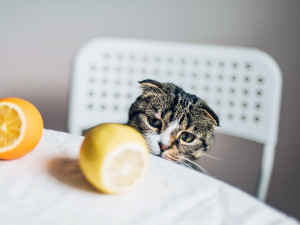The Internet Thinks Cats Are Liquid—Here’s Why They Really Can Squeeze Into That Vase
“A cat can generally fit into anything their head can fit into.”

Share Article
Videos of cats squeezing into vasesopens in new tab and other decidedly un-cat-shaped containersopens in new tab have been making the rounds on social media lately, often accompanied by some version of the hashtag #CatsAreLiquid.
Cats are, of course, vertebrates and very much “solid,” yet their ability to fill whatever space or vessel they enter — whether it’s a glass vaseopens in new tab, a sink basinopens in new tab, or even just a narrow bathroom dead spaceopens in new tab — makes them seem like some sort of high viscosity liquid. And given that one of the properties of liquid is that it conforms to the shape of its container, they sort of are.
But why do cats do it? What possible reason could there be for a cat to contort its body to fit into something as small and awkward as a vase? But really: how? How are they so bendy?
“Cats have more vertebrae than people do and between the bones is a gelatinous disk that helps them bend and flex in ways people and dogs cannot,” says veterinarian Dr. Gabrielle Fadl of Bond Vetopens in new tab. “Their spines are like little springs that can be compressed and extended, which is also part of what allows them to jump so far. Cats also have a clavicle that sort of floats, which allows their shoulders to contort and compress to help them get into these tight spaces.”
Okay, but how do they know they can fit where they want in the first place? “A cat can generally fit into anything their head can fit into,” says Dr. Fadl. ”So if their head can fit under or through something [like the neck of a glass vessel], the rest of their body should be able to as well, as long as there is room for it. They also use their whiskers to help measure space and get a full sensory picture of the situation.”

Do they ever misjudge and get stuck? “Typically, if they can wiggle themselves in then they can wiggle themselves out,” says Dr. Fadl.
There must be an evolutionary reason cats have developed these skills besides an inborn desire to fill a vase — and indeed there is. “[In the wild] cats are both predators and prey,” says Dr. Fadl. “That’s why they hide when they don’t feel well. Because they don’t want to be eaten. At the same time, they squeeze into small spaces in order to hide from their own prey. If they are crouched in a corner, then nothing can sneak up behind them, so [this ability] serves sort of a dual purpose.”
Feline behavior specialist Dr. Marci Koski of Feline Behavior Solutionsopens in new tab agrees. “[Squeezing into tight spaces] makes them feel safe,” she says. “That said, I have four cats and none of them enjoy [squeezing into vases], so I think that specific behavior is more the exception than the rule.”
It’s also a behavior more common in younger cats than in old cats, according to Dr. Fadl. “In general, I think younger cats [of any breed] that are of an ideal body weight tend to fit this profile a bit more,” she says. “Whereas an older cat might have some arthritis or mobility issues [that make it more difficult to squeeze into tight spaces comfortably].”
Of course, feline “liquidity” doesn’t just allow them to squeeze into tight spaces, it also enables them to make daring escapes, like a kitten squeezing through an air holeopens in new tab or the 2-inch wide space between the bars of its cageopens in new tab.
It can also, on occasion, get them into trouble. “When I was really little, we had a cat who climbed into our chimney and we had to cut into the wall to get him out,” says Dr. Koski. “So they do get stuck sometimes, but I suspect that might be more a case where they find themselves trying to get away from a predator.”
This extraordinary flexibility also helps cats evade predators in closer quarters. As anyone who has ever tried to grab a cat against their will can attest, they can be very difficult to get a handle on, when they want to be. It’s this same flexibility that allows them to quickly change direction while running and always land on their feet when falling from high places.
Their wonderful flexibility and tendency to hide in small spaces is really only a problem if your cat is squeezing into dangerous areas, says Dr. Koski, like if they are hiding between the dryer and the wall. “I’ve known cases where the cat got electrocuted in those situations, so if you know your cat likes to go into small places, it’s a good idea to block dangerous areas off,” she says. “Also, if your cat has a thing for squeezing into boxes, leave some boxes out for them. That’s a safe thing to do.”
What about vases? Are vases safe? “Sure,” says Dr. Fadl. “Although exactly why a cat would want to do that, I couldn’t say. I don’t know how you would be protecting yourself by squeezing into a clear vase with nowhere to go, but every cat is different and they often do things we don’t understand. I guess it is just one more reason to love them.”

Charles Manning
Charles Manning is an actor and writer based in New York City. In his free time he likes to cook, go swimming at the public pool, volunteer at the LGBTQ senior center, and foster senior and special-needs cats. His work has previously appeared in Cosmopolitan, Elle, Marie Claire, Harper’s Bazaar, Seventeen, and Nylon.
Related articles
![Home cat sitting on a chair with citrus.]()
Everything You Need to Know About Your Cat’s Incredibly Powerful Nose
They have up to 200 million odor receptors that can pick up all the good (and horrible) smells. Learn how to best support their sensitive sniffers.
![Man cuddling his gray cat.]()
Does Your Cat Think You’re Their Mom?
You love them like a child, but is the feeling mutual?
![Two cats walking with their tails sticking straight up]()
Cat Tail Meanings
Cats are enigmas. But their tail movements can reveal a lot about their moods.
![Cat grabbing onto ledge of table and looking to the left]()
Why Does My Cat Follow Me Everywhere?
Yes, they are right behind you.
![dark-haired woman hugging cat that has imprinted on her]()
10 Signs Your Cat Has Imprinted on You
Feeling like you have a little shadow these days? Here’s why that’s happening.
![orange cat sleeping on pillow]()
Can Cats Have Nightmares?
If so, they’re probably about going to the vet in that stupid carrier.








